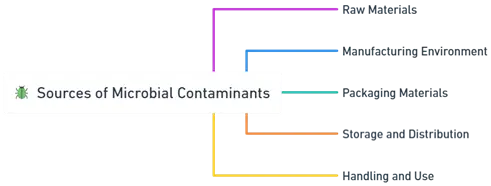Sources of microbial contaminants include sewage, animal waste, agricultural runoff, and contaminated water supplies.

1. Raw Materials as a Sources of microbial contaminants:
-
Water:
- Used in formulations can be a significant source of microbial contamination if not properly treated.
-
Active Pharmaceutical Ingredients (APIs):
- May harbour contaminants from their source or during processing.
-
Excipients:
- Ingredients like fillers, binders, and stabilizers can introduce microbes if not properly handled.
2. Manufacturing Environment:
-
Air:
- Airborne contaminants can settle on surfaces and products.
-
Surfaces and Equipment:
- Inadequately cleaned or sanitized surfaces and equipment can harbor microbes.
-
Personnel:
- Human operators can introduce contaminants through skin, clothing, or respiratory droplets.
Advertisements
3. Packaging Materials:
-
Containers and Closures:
- Can introduce contaminants if not sterile or if compromised during storage.
-
Packaging Process:
- Can lead to contamination if not conducted under sterile conditions.
4. Storage and Distribution:
-
Storage Conditions:
- Improper temperature and humidity can promote microbial growth.
-
Transportation:
- Contaminated transportation environments can introduce or promote the growth of microbes.
5. Handling and Use:
-
Consumer Handling:
- Improper handling by consumers can introduce contaminants.
-
Healthcare Settings:
- Contaminated environments or improper handling during administration can lead to contamination.

